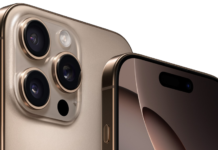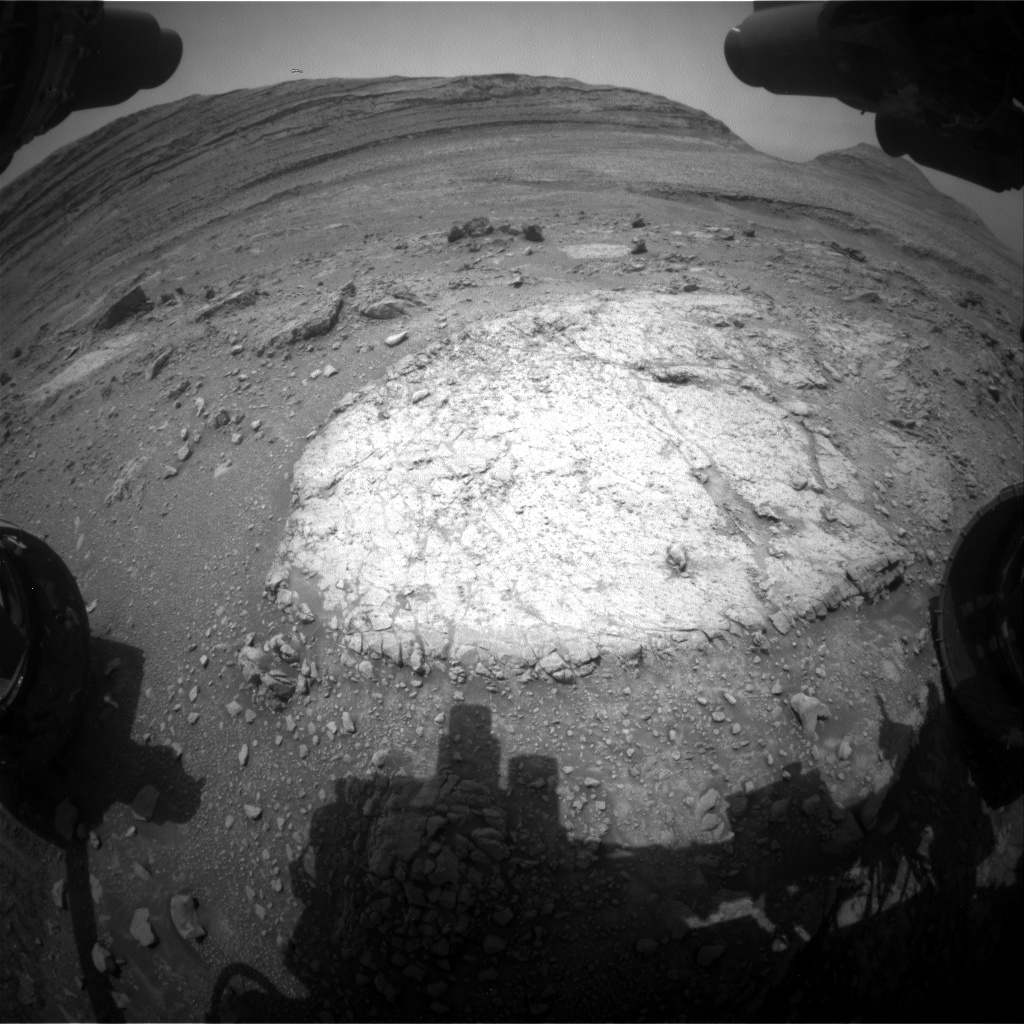Curiosity Rover’s Return to McDonald Pass: Scientific Endeavors on Mars
NASA’s Curiosity Rover has once again made its way back to "McDonald Pass," a significant site within the Gediz Vallis region on Mars. This location was first identified about a month ago and is highlighted by its distinct zonation, which refers to the distribution of different textures and colors in various areas. By studying these zones closely, scientists hope to gain insights into similar geological features observed elsewhere on Mars.
A Glimpse into the Mission
On September 3, 2024, or sol 4293 of the Mars Science Laboratory mission, Curiosity captured an image using its Front Hazard Avoidance Camera (Front Hazcam). This grayscale photograph showcases a landscape filled with rocks and pebbles, dominated by a large, lighter-colored rock slab at its center. The rover’s parts are visible at the corners of the image, and in the distance, two large, layered buttes rise from the ground.
Curiosity’s return to McDonald Pass was meticulously planned. The team realized that the best spot to study the unique zonation was directly beneath the rover. Consequently, the plan included detailed contact science and a short repositioning maneuver to optimize the rover’s position for further scientific investigations.
A Day in the Life of Curiosity’s Mission Planning
The mission’s planning date coincided with a U.S. holiday, making it a rare single-sol plan. The day was straightforward once the team identified the optimal locations for contact science. The plan began with a Dust Removal Tool (DRT) and the Alpha Particle X-Ray Spectrometer (APXS) on a central part of the slab, dubbed "Erin Lake."
Following this, a series of remote sensing tasks were scheduled. These included environmental monitoring to search for dust devils, measuring atmospheric opacity, and observing the movement of fine particles on the rover’s deck. The Geology Theme group planned to use the Chemistry and Camera complex (ChemCam) Laser-Induced Breakdown Spectroscopy (LIBS) on the darker gray rim of the block, named "Paris Lake." Additionally, a ChemCam passive observation was set for an intriguing dark float block nearby.
A long-distance Remote Micro-Imager (RMI) mosaic was also planned to assess the yardang unit higher on Mount Sharp. A yardang is a streamlined hill carved from bedrock or any consolidated material by the dual action of wind abrasion by dust and sand and deflation, which is the removal of loose material by wind turbulence. Finally, a Mast Camera (Mastcam) mosaic would evaluate the textures in a row of large clasts.
In the afternoon, Curiosity was scheduled to capture Mars Hand Lens Imager (MAHLI) images of Erin Lake and another target named "Picture Puzzle," which encompasses the white, gray, and tan zones. Following this, Curiosity would execute a short drive back about one meter to position a white and gray clast within its workspace for even more contact science the next day.
The Significance of McDonald Pass
McDonald Pass presents an opportunity to study the zonation patterns in Martian geology closely. By understanding the distribution and relationships between the different colored and textured materials, scientists can draw parallels to similar features observed in other Martian regions. This could provide invaluable insights into the planet’s geological history and the processes that have shaped its surface.
Technological Marvels: Curiosity’s Instruments
Curiosity is equipped with a suite of scientific instruments designed to explore Mars’ surface and analyze its geological features. Here’s a brief overview of some key instruments mentioned:
- Front Hazcam: This camera helps the rover avoid hazards and choose safe paths as it navigates the Martian terrain.
- DRT (Dust Removal Tool): Used to clean the surface of rocks, allowing the rover’s instruments to analyze them without the interference of dust and debris.
- APXS (Alpha Particle X-Ray Spectrometer): Measures the abundance of chemical elements in rocks and soil.
- ChemCam (Chemistry and Camera complex): Performs remote chemical analyses and captures detailed images.
- RMI (Remote Micro-Imager): A high-resolution camera that captures detailed images of distant objects.
- Mastcam (Mast Camera): Captures high-resolution images and videos, providing detailed views of the Martian landscape.
- MAHLI (Mars Hand Lens Imager): A camera that takes close-up images of rocks and soil, similar to a geologist’s handheld magnifying glass.
The Broader Impact of Mars Exploration
Curiosity’s mission is part of a larger effort to explore Mars and understand its potential to support life, past or present. The rover’s findings contribute to our knowledge of the planet’s climate and geology, helping scientists piece together Mars’ history.
Moreover, this mission lays the groundwork for future human exploration of Mars. By understanding the planet’s surface and environmental conditions, we can better prepare for the challenges of sending humans to Mars. This includes developing technologies for life support, habitat construction, and resource utilization.
Curiosity’s Journey: A Timeline
Curiosity has been exploring Mars since it landed in Gale Crater on August 6, 2012. Here are some notable milestones in its journey:
- 2012: Curiosity lands on Mars and begins its mission to explore Gale Crater.
- 2013: The rover discovers evidence of ancient freshwater lakes, suggesting that Mars could have supported microbial life.
- 2014: Curiosity begins its ascent of Mount Sharp, a central peak within Gale Crater, to study its layered rock formations.
- 2015: The rover finds evidence of organic molecules in Martian rocks, further supporting the possibility of past life.
- 2018: Curiosity detects seasonal variations in methane levels in the Martian atmosphere, hinting at active processes on the planet.
- 2021: The rover continues to explore new regions within Gale Crater, conducting detailed analyses of rock formations and soil.
Community Reactions and Reviews
The scientific community and space enthusiasts alike have been closely following Curiosity’s mission. The rover’s discoveries have sparked excitement and curiosity, fueling our fascination with the Red Planet.
Dr. Lauren Edgar, a planetary geologist at the USGS Astrogeology Science Center, has been actively involved in planning the rover’s activities. She emphasizes the importance of studying the zonation at McDonald Pass, as it could unlock new understanding of Martian geology.
Space enthusiasts have also expressed their admiration for the rover’s achievements. Social media platforms are abuzz with discussions about Curiosity’s latest findings, with many eagerly awaiting updates from NASA.
Conclusion
Curiosity’s return to McDonald Pass marks another significant step in our exploration of Mars. By studying the unique zonation patterns at this site, scientists hope to unravel the mysteries of the planet’s geological history. The rover’s sophisticated instruments and meticulous planning ensure that each step brings us closer to understanding Mars’ past and its potential to support life.
Stay tuned for more updates from Curiosity as it continues its journey across the Martian surface, uncovering new secrets and expanding our knowledge of the Red Planet.
For detailed information and updates on Curiosity’s mission, you can visit NASA’s official Curiosity Mission page.
For more Information, Refer to this article.




















![The Apex Legends Digital Issue Is Now Live! Apex Legends - Change Audio Language Without Changing Text [Guide]](https://www.hawkdive.com/media/5-Basic-Tips-To-Get-Better-On-Apex-Legends-1-218x150.jpg)






